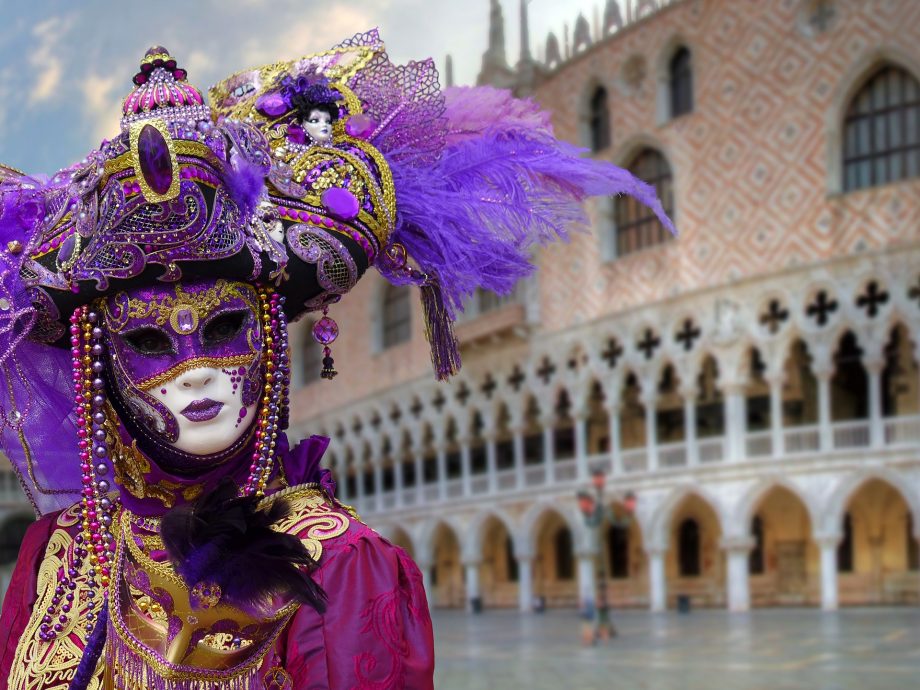11th – 28th February 2017, sees the highest point in Venice’s social calendar: Carnevale. This masked extravaganza is an excuse to let your hair down, dress up in 18th century garb and spend two weeks wearing the most beautifully hand decorated masks, if the mood should take you. Next to Rio’s Carnival, this is the world’s best known, two week long, baroque fancy dress party. Carnevale, what we translate as carnival, actually is Italian for ‘farewell to meat’. This festival is the yearly pre-Lent celebrations. It builds up for 10 days, until its climax on Shrove Tuesday (Mardi Gras), when fireworks illuminate the Grand Canal, and Piazza San Marco is turned into a giant open-air ballroom for the masses.
History
Venetians have been celebrating Carnevale in La Serenissima (Venice’s old nickname) since at least the 15th century. Private clubs organised masked balls then, attended by well-heeled revellers from all over Europe. By the 18th century, Venice was in the grip of hedonism, as its economy, colonies and trading posts fell to other powers, so the people of Venice turned to fantasy and escapism, to buoy their spirits. Masks became ubiquitous, affording anonymity and the pardoning of a thousand sins. The licentious goings-on of Carnevale lasted for two months: from St. Stephens day, culminating at midnight on Shrove Tuesday. The doges condemned it and the popes denounced it, but nothing could dampen the Venetian Carnevale spirit until Napoleon seized the city in 1797 and the event fell out of favour. It was eventually forgotten altogether when Mussolini banned the wearing of masks. Its revival came in 1980, reclaiming its position on the world stage as one of the world’s finest festivals.
Current Carnival
Venetians today, take to the open piazzas and streets for the pre-Lent celebrations of Carnevale. Resuscitated in 1980 by local tourism powers, to fill the empty winter void when tourism comes to an abrupt halt, Carnevale is calmer today than it used to be, though just barely. The masked balls are often private affairs; those where tickets are available are sumptuous, with candlelit banquets calling for extravagant costumes and even more flamboyant masks. If you can get tickets, splurge on the Ballo del Doge, or Doge’s Ball. This is a real jet-set party (accessible to all) in the 16th-century Palazzo Pisani-Moretta on the Grand Canal. It is sumptuously outfitted with Tiepolo frescoes and all the other accoutrements of 18th-century Venetian style. The many different ballrooms feature minuets, waltzes and baroque chamber orchestras. There is even a modern disco, and it is all catered by the Do Forni restaurant.
Carnivale not just a mass of masked balls, although they do still feature heavily, it is a harlequin patchwork of musical and cultural events, many of them free of charge. Musical events are staged in some of the city’s piazzas. Special art exhibits are mounted at museums and galleries. The city is the perfect venue: Hollywood could not create a more evocative location. This is a celebration of history, art, theatre, and drama that one would expect to find in Italy, the land of Renaissance and Zeffirelli, and Venice: an ancient and wealthy republic that gave us Casanova and Vivaldi. Yes, Venice and Carnevale were made for each other.
The celebration starts the meat-free period of Lent, and so party goers in the past would use up the rich ingredients they had to hand. To compliment the savoury dishes often eaten during the Carnival period, Venetians invented the sweet treat called fritelle. A fried ball of pastry dough, often filled with cream or nutella and sprinkled with powder sugar. It can only be found during Carnevale so be sure not to miss it.
If you arrive during the first week you might wonder what all the fuss is about: there’s not a huge lot to keep you entertained. If it’s excitement you’re after, come for the weekends, especially the weekend preceding Shrove Tuesday. Bear in mind though that Carnevale is not for the faint hearted. For two weeks all of Venice becomes a stage. It is a wonderful opportunity to create an extravagant costume or rent one from the countless stands set up about the town, and give in to the spontaneity of magic and surprise around every corner, the mystery behind every mask. And masks are everywhere.
Masks
The Venetian propensity for hiding behind masks was legendary: wearing a mask enabled the wearer to indulge in frivolous activities, anonymously, that they wouldn’t normally be allowed to partake in. Knowing this was going on, in 1608, the law makers (the Council of the Ten) stipulated when, throughout the year, masks could be worn: and so began the crescendo of merry making, from Boxing Day until Shrove Tuesday – the period known as Carnevale.
There is next to no point in observing Carneval as a mere onlooker; without a mask, you don’t get the full experience. To obtain the real thing, rather than a far-eastern import, head for traditional mascarei (mask makers) such as Ca’ Macanà, Tragicomica or Papier Maché. These artisans produce some dramatic creations, but Venetians of old favoured the utmost simplicity: the plain white volto. Venetian masks can be made of leather, porcelain or using the original glass technique. The original masks were rather simple in design, decoration, and often had a symbolic and practical function. Nowadays, most Italian masks are made with the application of gesso and gold leaf and are hand-painted using natural feathers and gems to decorate.
There are several types of Venetians masks: the bauta, which is the most traditional, the moretta, the volto, the columbina, and the birdlike mask of the Plague Doctor. The choice is yours!

